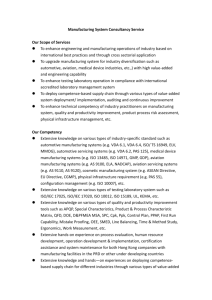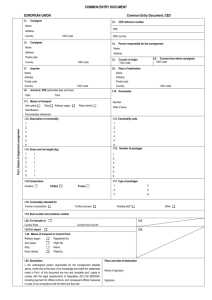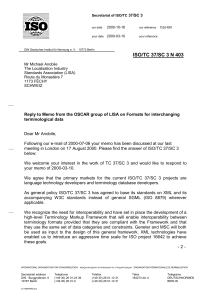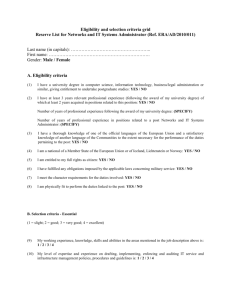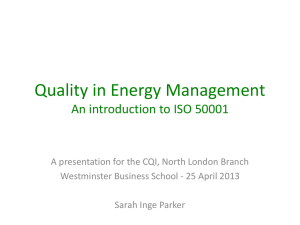The astrophysics programme encompasses three themes
advertisement
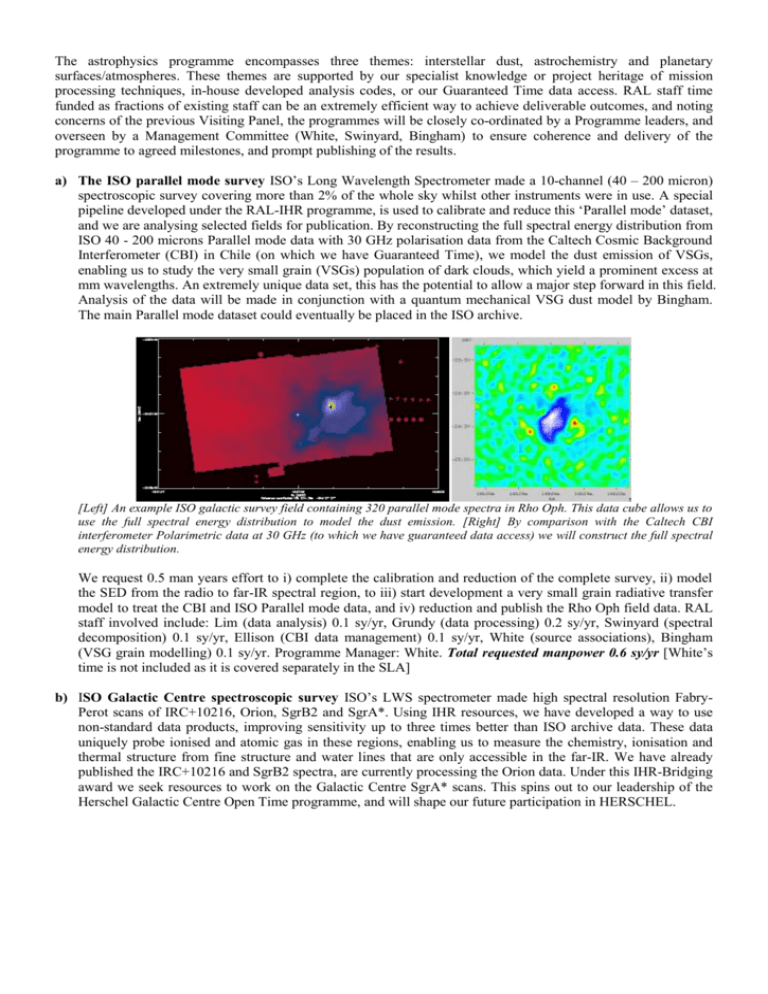
The astrophysics programme encompasses three themes: interstellar dust, astrochemistry and planetary surfaces/atmospheres. These themes are supported by our specialist knowledge or project heritage of mission processing techniques, in-house developed analysis codes, or our Guaranteed Time data access. RAL staff time funded as fractions of existing staff can be an extremely efficient way to achieve deliverable outcomes, and noting concerns of the previous Visiting Panel, the programmes will be closely co-ordinated by a Programme leaders, and overseen by a Management Committee (White, Swinyard, Bingham) to ensure coherence and delivery of the programme to agreed milestones, and prompt publishing of the results. a) The ISO parallel mode survey ISO’s Long Wavelength Spectrometer made a 10-channel (40 – 200 micron) spectroscopic survey covering more than 2% of the whole sky whilst other instruments were in use. A special pipeline developed under the RAL-IHR programme, is used to calibrate and reduce this ‘Parallel mode’ dataset, and we are analysing selected fields for publication. By reconstructing the full spectral energy distribution from ISO 40 - 200 microns Parallel mode data with 30 GHz polarisation data from the Caltech Cosmic Background Interferometer (CBI) in Chile (on which we have Guaranteed Time), we model the dust emission of VSGs, enabling us to study the very small grain (VSGs) population of dark clouds, which yield a prominent excess at mm wavelengths. An extremely unique data set, this has the potential to allow a major step forward in this field. Analysis of the data will be made in conjunction with a quantum mechanical VSG dust model by Bingham. The main Parallel mode dataset could eventually be placed in the ISO archive. [Left] An example ISO galactic survey field containing 320 parallel mode spectra in Rho Oph. This data cube allows us to use the full spectral energy distribution to model the dust emission. [Right] By comparison with the Caltech CBI interferometer Polarimetric data at 30 GHz (to which we have guaranteed data access) we will construct the full spectral energy distribution. We request 0.5 man years effort to i) complete the calibration and reduction of the complete survey, ii) model the SED from the radio to far-IR spectral region, to iii) start development a very small grain radiative transfer model to treat the CBI and ISO Parallel mode data, and iv) reduction and publish the Rho Oph field data. RAL staff involved include: Lim (data analysis) 0.1 sy/yr, Grundy (data processing) 0.2 sy/yr, Swinyard (spectral decomposition) 0.1 sy/yr, Ellison (CBI data management) 0.1 sy/yr, White (source associations), Bingham (VSG grain modelling) 0.1 sy/yr. Programme Manager: White. Total requested manpower 0.6 sy/yr [White’s time is not included as it is covered separately in the SLA] b) ISO Galactic Centre spectroscopic survey ISO’s LWS spectrometer made high spectral resolution FabryPerot scans of IRC+10216, Orion, SgrB2 and SgrA*. Using IHR resources, we have developed a way to use non-standard data products, improving sensitivity up to three times better than ISO archive data. These data uniquely probe ionised and atomic gas in these regions, enabling us to measure the chemistry, ionisation and thermal structure from fine structure and water lines that are only accessible in the far-IR. We have already published the IRC+10216 and SgrB2 spectra, are currently processing the Orion data. Under this IHR-Bridging award we seek resources to work on the Galactic Centre SgrA* scans. This spins out to our leadership of the Herschel Galactic Centre Open Time programme, and will shape our future participation in HERSCHEL. [Left] The RAL Orion LWS Fabry-perot scan, (from the current IHR award), showing 107 spectral lines [Right] CLOUDY analysis of the ionisation state of lines in the SGRA* grating map revealing a strong, but soft radiation field We request 0.3 man years effort to i) reduce the new SgrA* data sets, ii) use these with our existing chemical and radiative transfer models to estimate the abundances and excitation in the various lines (radiative transfer codes from White and astrochemical models through our UCL collaboration), iii) prepare the data for publication. RAL staff involved include: Lim (analysis) 0.1 sy/yr, Grundy (data analysis) 0.2 sy/yr, Swinyard (line analysis) 0.1 sy/yr, (+ White original programme co-PI, and PI on the equivalent SgrA* Grating programme, line excitation and analysis). Programme Manager: Swinyard. Total requested manpower 0.4 sy/yr c) Data analysis for the Mar Express PFS programme The MARS Express mission Planetary Fourier Spectrometer (PFS) (1 – 50 mm) has been involved in the recent controversial studies that have suggest high concentrations of water vapor and methane in the atmosphere of Mars, which significantly overlap. The instrument PFS principal investigator, Professor Formisano, has offered us the opportunity to lead the data reduction and processing of several hundred thousand spectra from this instrument in exchange for our time. Science objectives of the PFS are to measure: Temperature and thermophysical properties of Martian soil; gather data about mineralogical composition of surface; study surface condensates; and perform altimetry. [Left] Mars PFS spectrum of the sort we will have access to [Center] Global bolometric visible/near-IR Albedo map of Mars from the MGS TES experiment., [Right] Thermal inertia map of Mars between 50° South and 60° North from the MGS TES experiment We would like to participate in PFS data reduction, the outputs of which will be used in conjunction with the RAL thermal inertia mapping we have recently worked on under our IHR programme. The combination of these two data sets will allow us to study: 3-D temperature and pressure fields; make a global maps of winds; study temporal and spatial variations of H2O and CO2; map aerosols optical depth, phase function, size distribution and chemical composition of particles. The thermal data provide the background emission against which the PFS spectra are referenced, and it only by bringing these two datasets together at RAL that we can fully interpret the PFS data This outstanding strategic opportunity should provide a large scientific gain for a small investment in manpower - the already controversial and well publicised data from this instrument suggesting a rich scientific return. Our group has led interpretation of the rotational modulation of the Martian thermal inertial analysis, and also has access to the crucial surface temperature modelling data, and radiative transfer and atmospheric modelling codes through our collaborations with Oxford This work will involve involve Walker (analysis) 0.2 sy/yr, Sidher (thermal and atmospheric modelling) 0.2 sy/yr, Grande (atmospheres) 0.1 sy/yr. Programme Manager: Walker. Total requested manpower 0.5 sy/yr d) Dust, Gas and shock front interactions in Cas A. We will study the interactions of ionised shock fronts with the ISM by looking in the Cas A SNR. We will use the theoretical work of Bingham (RAL) with the ISOLWS data to examine conditions in a young oxygen rich supernova, that appear to challenge the current theoretical models of this object as they unexpectedly reveal the presence of cold (< 40 K) gas entrained within the superheated plasma. The right hand image shows Spitzer 24 m contours over the Hubble optical image of the [OIII] emission. The 24 micron data trace the presence of warm dust – probably MgSi0x (Douvion et al 2001 AA 369 pp589) whilst the [OIII] optical traces the very hot plasma at the interaction sites between the shock front and the cold material shed in an earlier phase of the progenitor’s evolution. The ISO LWS spectrum of the northern part of Cas A (right] in [OIII]52 (red);[OIII]88 (green) and [OI]63 reveals gas at <40K and that both the hot plasma and the cold gas have the same bulk motion. Using theoretical models of shock fronts interacting with the dusty ISM, developed by Bingham & Kellett (both RAL) will predict x-ray emission from predict the temperature; ionisation and density of the complex structures known to be present in Cas A. Using the CHIANTI code we will compare the x-ray emission and compare this to XMM and Chandra observations, and the CLOUDY photoionization code to model the mid and far infrared lines seen by ISO. Resources: Swinyard (data analysis) 0.1 sy/yr, White (shock and ionisation modelling), Grundy (data analysis) 0.1 sy/yr, Young (photoionisation modeling) 0.1 sy/yr, Bingham (dust properties, shock modelling) 0.1 sy/yr, Kellett (CHIANTI, shock modelling) 0.1 sy/yr, Young (neutral-plasma interactions) 0.1 sy/yr. Programme Manager: Swinyard. Total requested manpower 0.6 sy/yr e) Future HERSCHEL GT/OT preparatory studies We hold leadership positions in the preparatory programmes for the future HESCHEL mission: Membership of the four main SPIRE Guaranteed Time Teams, ISM, Galactic, Extragalactic and Solar System (Swinyard, Sidher, Lim, Walker, White) Members of the HiGAL Open Time Consortium (Swinyard, White, Sidher) PI and organisers of the Galactic Centre Open Time Programme (White, Swinyard) We request a small allocation of IHR resources for manpower and T&S to enable our continued participation and organisation of these teams. Although the science return for these is less quantifiable than in the other programmes listed here, the small amount of resources put us in a strong position to bring forward programmes that will feature in the next full Rolling Grant application. Programme Manager: White Total requested manpower 0.1 sy/yr Overall Programme Summary: The ISO parallel mode survey ISO Galactic Centre spectroscopic survey Data analysis for the Mar Express PFS programme Dust, Gas and shock front interactions in Cas A. Future HERSCHEL GT/OT preparation Totals 0.6 sy/yr 0.4 sy/yr 0.4 sy/yr 0.6 sy/yr 0.1 sy/yr _______ 2.1 sy/yr


